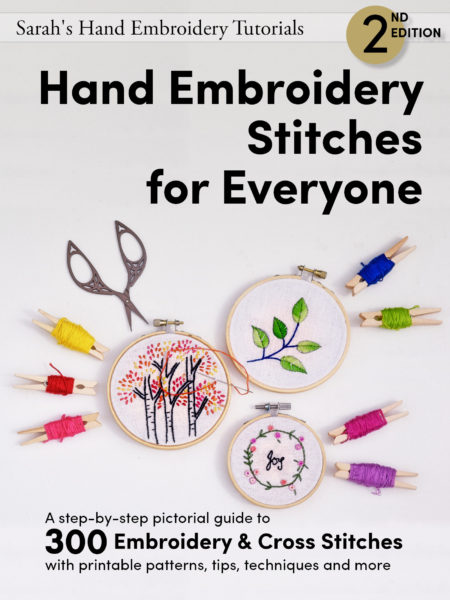About Satin Stitch Family
Satin stitch is probably one of the most beautiful stitches when done properly. It is equally difficult in certain ways. This family of stitches focuses on filling a motif using a series of stitches done close to each other. While doing this stitch, it is important to pay attention to the neatness of the outline and to keep each stitch close to each other to give it a satin finish. When it comes to filling in a pattern with a smooth texture, nothing beats the Satin Stitch.
Satin Stitch is also, probably, one of the most common stitches in machine embroidery.
Satin Stitch in Embroidery
There are different varieties of satin stitch, each to suit the pattern to be done. Many cultures use Satin Stitch for their embroidery purposes. It is found in North Africa, South America, western Asia, south-eastern Asia, and the Indian subcontinent. Amongst all, China used it in plenty. Many robes have been decorated using the satin stitch in the finest way in ancient China. The folk embroideries of Korea, Japan, Indonesia, and Vietnam include techniques adapted from China. The skills of creating satin stitch images were carried to an extent where double-sided images were created on a single piece of silk. This is an extremely complicated technique with its roots believed to be from the third century.
In India, one of the well-known Satin Stitch embroideries is the ‘Phulkari‘ from the Punjab region. ‘Phulkari‘ means ‘flower work’ and the finest of them is called ‘bagh‘, which means ‘garden’. It is done in a marigold-colored thread over a rust-colored cloth. The importance of ‘Phulkari‘ shawls still prevails amongst women of India and Pakistan. When a girl is born, her maternal grandmother begins embroidering a ‘bagh‘ which later becomes a part of the trousseau during the girl’s wedding.
Satin Stitch Family
Surface Satin |
Back Stitched Satin | |
Trailing Stitch |
Double Satin |
Learn these stitches and more from our 600-page eBook.

![Damask Stitch [EN], Puntos Plano [ES], Passé plat [FR], Plattstich / Flachstich [DE], Punto piatto [IT], Ponto cheio [PT], Plattsöm [SV]](https://www.embroidery.rocksea.org/images/embroidery/satin_stitch_index_2.jpg)


![Puntada de satén acolchada [ES], Point de plumetis [FR], unterlegter Plattstich [DE], Punto piatto imbottito [IT], Ponto cheio com enchimento [PT]](https://www.embroidery.rocksea.org/images/embroidery/padded_satin_index_2.jpg)

![Long and short stitch [EN], Punto matizado / Punto pasado alternado / Punto largo y corto [ES], Passé empietant [FR], Versetzter Plattstich / Nadelmalerei [DE], Punto pittura / Punto raso [IT], Ponto matiz [PT]](https://www.embroidery.rocksea.org/images/embroidery/brick_stitch_index_2.jpg)













Hope everything is going OK with you and your family. I’m sending you my latest embroidery. This one took a while as it is very detailed. Hope yu lik it. I’ve always had trouble placing my creations on your site . HAVE A GREAT DAY AND STAY WELL. SENDING LOVE ANE HUGS
Sorry, the last 4 stitches links are broken xx
I wish to make double-sided Phulkari. So far I plan to use Satin Stitch to fill in areas. What are other embroideries that decorate double-side
Hi Priya. It is great that you are attempting a double-sided Phulkari.
Here are some other double-sided embroidery styles:
1. Kasuti using Holbein Stitch: Lessons here: https://www.embroidery.rocksea.org/hand-embroidery/kasuti/kasuti-lesson-1/
2. Blackwork using Holbein Stitch. Similar to Kasuti, but uses other pattern styles.
3. Reversible Pattern Darning using Darning Stitch. Lessons here: https://www.embroidery.rocksea.org/hand-embroidery/pattern-darning/pattern-darning-lesson-2/
4. Hitomezashai using the Running Stitch.
Hope this helps.
The flower part of the stitching, is that also satin? Just off-set? It is lovely, give almost a chenille effect.
Hi Judy,
The flower part of stitch is a kind of satin stitch you might say. It is the brick stitch, aka long stitch.
I have apattern that calls for a star stitch. I have snowflakes and stars in the pattern, cannot find how to make the stars.
hello Sarah!!
satin stitch is probably most easy but most skill demanding stitch .i have tried but can u suggest some tips about working it on curvy lines and sharp angles.
Dear Navneet,
Very true: Satin stitch, as much easy as it looks, it demands practice and precision for a good quality.
While working on curvy lines, keep the stitches closer inwards. Sometimes, the stitch points might overlap in the inner curve.
For sharp angles, the same technique might apply. But, depending on each pattern, the fabric you use and the needle and thread, you will have to check if it is practical or not. Else, it is better to do satin stitch horizontally first, then, start the vertical way. This avoids you from doing a sharp angled turn, that is not always possible neatly.
I hope this helps. 🙂
Hello.. Do you personally teach stitching in any class, would like to join immediately…:)
Hello Avlin,
I do teach hand embrodiery personally. It is conducted at Pashan-Panchvati in Pune.
You can check this post for more details: https://www.embroidery.rocksea.org/reference/summer-workshop/
very nice and informative
🙂
i would like to know buttonhole stitch. Could you please upload the procedure.
Dear Alka,
I have the buttonhole stitch and it’s members in my tutorial list. It will take some time for me to upload new stitches as we are in the middle of shifting to a new place and settling down. 🙂
Hi! Your work is so beautiful & lovely.
Also would like to know the threads your have used dosen’t look like Anchor. What thread should we use to look the embroidery so beautiful.
Thanks & Regards,
Darshana
Dear Darshana,
Thanks for your comments. To do satin stitch family, I have used perle cotton. I thought this thread would describe the pictures clearly. 🙂 Otherwise too, many times perle cotton makes the filling look neater and more beautiful than anchor thread.